EDMR: An Enhanced Dynamic Multi-Hop Routing Protocol with a Novel Sleeping Mechanism for Wireless Sensor Networks
Abstract
1. Introduction
- (1)
- Propose the EDMR protocol as an enhanced version of the DMR protocol to reduce energy dissipation and prolong the network’s lifetime;
- (2)
- Introduce a novel sleeping mechanism to selectively deactivate clusters that have not transmitted new or significantly updated data to the BS. Unlike many previous sleep-based protocols that maintain fixed sleeping approaches at the node or cluster level throughout each round, the proposed protocol provides two alternative sleeping scenarios based on the WSN’s demands:
- The static sleep scenario is designed for monitoring applications, where the sensed data typically do not change rapidly. Consequently, maximum energy savings can be achieved while preserving the network’s performance and intended functionality;
- The dynamic sleep scenario departs from static assumptions by allowing sleep/wake states to be adjusted within the same round. Accordingly, the cluster nodes update their status in response to real-time events occurring within the network. This intra-round adaptability enables efficient energy conservation while maintaining the network’s coverage and performance;
- (3)
- Utilize the INs distributed across the network, including those located near sleeping clusters, to collect and forward data to the BS. These INs also provide valuable feedback that supports future sleep decisions. By combining the dual-sleep mode design with real-time operational awareness, the EDMR protocol offers a more adaptable sleep management strategy than traditional protocols, which are typically based on fixed or non-responsive mechanisms;
- (4)
- Integrate the proposed sleeping mechanism with the dynamic routing technique to ensure consistent data flow and minimize energy usage.
2. Related Work
3. Dynamic Multi-Hop Routing (DMR) Technique
3.1. Energy Dissipation Model
3.2. Phases of the DMR Protocol
3.2.1. The Initialization Phase
3.2.2. The Announcement Phase
3.2.3. The Table Preparation Phase
3.2.4. The Routing Phase of the DMR Protocol
- Intra-cluster Routing
- Inter-cluster Routing
4. Enhancing the Dynamic Multi-Hop Routing (EDMR) Protocol
4.1. The Network Architecture Phase
| Algorithm 1: Table Preparation Sub-Phase | |
| Definitions the set of Ns located at distance ≥ do/2 from the CH | |
| the set of Ns located in the lower levels | |
| the set of CHs/INs located at distance ≥ do/2 from the BS CH[n]/IN[n] ∈ the set of CHs/INs located at distance ≥ do/2 from the BS RT: Routing Table | |
| Ann_Mess: Announcement message | |
| Join_Req: Join Request message Acc_Mess: Acceptance message | |
| 1: | begin |
| 2: | for each (N[i]) |
| 3: | if (received Ann_Mess from N[j]) then |
| 4: | send Join_Req to N[j]; |
| 5: | end if |
| 6: | for each (N[j]) received Join_Req |
| 7: | if (has available in its TDMA table) then |
| 8: | assign a slot to N[i]; |
| 9: | send Acc_Mess to N[i]; |
| 10: | end if |
| 11: | end for |
| 12: | for each (Acc_Mess received from N[j]) |
| 13: | compute cost (N[i], N[j]); |
| 14: | add (N[j], cost (N[i], N[j])); |
| 15: | sort RT[i] in ascending order; |
| 16: | end for |
| 17: | end for |
| 18: | for each (CH[m]/IN[m]) |
| 19: | if (received Ann_Mess from CH[n]/IN[n]) then |
| 20: | send Join_Req to CH[n]/IN[n]; |
| 21: | end If |
| 22: | for each (CH[n]/IN[n]) |
| 23: | if (has available in its TDMA table) |
| 24: | assign a slot to CH[m]/IN[m]; |
| 25: | send Acc_Mess to CH[m]/IN[m]; |
| 26: | end if |
| 27: | end for |
| 28: | for each (Acc_Mess from CH[n]/IN[n]) |
| 29: | compute cost (CH[m]/IN[m], CH[n]/IN[n]); |
| 30: | add (CH[n]/IN[n], cost (CH[m]/IN[m], CH[n]/IN[n])); |
| 31: | sort RT[m] in ascending order; |
| 32: | end for |
| 33: | end for |
4.2. The Routing Phase of the EDMR Protocol
4.2.1. The Initial Routing Sub-Phase
| Algorithm 2: Initial Routing Sub-Phase | |
| Definitions the set of Ns located at distance ≥ do/2 from the BS | |
| the set of CHs/INs located at distance ≥ do/2 from the BS | |
| RT: Routing Table | |
| NXN: Next hop node (N) | |
| NIN: Next hop node (CH/IN) | |
| DN[i]-CH: Distance from N[i] to its corresponding CH | |
| RRT[i]-CH: Set of available routes in RT for N[i] to reach CH DCH[m]/IN[m]-BS: Distance from CH[m]/IN[m] to BS RRT[m]-BS: Set of available routes in RT for CH[m]/IN[m] to reach BS | |
| 1: | begin |
| 2: | for each (N[i]) |
| 3: | if (DN[i]-CH < do/2) |
| 4: | transmit sensed data directly to the CH; |
| 5: | else if (DN[i]-CH < RST[i]-CH) |
| 6: | transmit sensed data directly to the CH; |
| 7: | else |
| 8: | select NXN from RT[i]; |
| 9: | transmit the sensed data to the CH through it; |
| 10: | end if |
| 11: | end for |
| 12: | for each (CH[m]/IN[m]) |
| 13: | if (DCH[m]/IN[m]-BS < do/2) |
| 14: | transmit aggregated data directly to the BS; |
| 15: | else If (DCH[m]/IN[m]-BS < RRT[m]-BS) |
| 16: | transmit the aggregated data directly to the BS; |
| 17: | else |
| 18: | select NIN from RT[m]; |
| 19: | transmit aggregated data to the BS through it; |
| 20: | end if |
| 21: | end for |
4.2.2. The Active/Sleep Sub-Phase
Static Sleeping Scenario
| Algorithm 3: Static Sleeping Scenario | |
| Definitions | |
| the set of CHs | |
| TH: Threshold value N: Normal node | |
| Vnew: the new data value Vpre: the previously stored data value | |
| Δ: the relative difference | |
| 1: | begin |
| 2: | for each (CH[m]) |
| 3: | transmit Vnew to the BS; |
| 4: | for each (Vnew received by BS from CH[m]) |
| 5: | Compute Δ; |
| 6: | if (Δ < TH) |
| 7: | mark cluster [m] as deactivated; |
| 8: | send broadcast message (CH[m]_ID, mode_bit = 1); |
| 9: | else |
| 10: | mark CH[m] as activated; |
| 11: | end if |
| 12: | end for |
| 13: | if (CH[m] received broadcast message from the BS) |
| 14: | CH[m] broadcasts a sleep message to its Ns; |
| 15: | Ns enter sleep mode; |
| 16: | remain CH[m] active; |
| 17: | else |
| 18: | remain Ns active; |
| 19: | end if |
| 20: | end for |
Dynamic Sleeping Scenario
| Algorithm 4: Dynamic Sleeping Scenario | |
| Definitions | |
| the set of CHs | |
| TH: Threshold value N: Normal node | |
| Vnew: the new data value Vpre: the previously stored data value | |
| Δ: the relative difference | |
| Max_Cycle: maximum cycle number in the round | |
| 1: | begin |
| 2: | // cycle 1: Initial Evaluation |
| 3: | for each (CH[m]) |
| 4: | transmit Vnew to the BS; |
| 5: | for each (Vnew received from the BS) |
| 6: | compute Δ; |
| 7: | if (Δ < TH) |
| 8: | mark cluster [m] as deactivated; |
| 9: | send broadcast message (CH[m]_ID, mode_bit = 1); |
| 10: | else |
| 11: | mark CH[m] as activated; |
| 12: | end if |
| 13: | end For |
| 14: | If (CH[m] received a broadcast message from the BS) |
| 15: | CH[m] broadcasts a sleep message to its Ns; |
| 16: | Ns of this cluster enter sleep mode; |
| 17: | remain CH[m] active; |
| 18: | else |
| 20: | remain Ns active |
| 21: | end if |
| 22: | end for |
| 23: | // from cycle 2 to the maximum number of cycles in the round |
| 24: | while (cycle ≤ Max_cycle) |
| 25: | for each (CH[m]) |
| 26: | if (CH[m] received reactivate message) |
| 27: | CH[m] broadcasts activate message to its Ns; |
| 28: | Ns of the cluster [m] start sensing and transmit their data to CH[m]; |
| 29: | else |
| 30: | the cluster[m] remains in deactivate mode; |
| 31: | end if |
| 32: | if (CH[m] received a deactivate message from the BS) |
| 33: | CH[m] broadcasts a sleep message to its Ns; |
| 34: | Ns of this cluster enter sleep mode; |
| 35: | remain CH[m] active; |
| 36: | end if |
| 37: | cycle++; |
5. Simulation and Results
6. Conclusions
Author Contributions
Funding
Institutional Review Board Statement
Informed Consent Statement
Data Availability Statement
Conflicts of Interest
References
- Kandris, D.; Nakas, C.; Vomvas, D.; Koulouras, G. Applications of Wireless Sensor Networks: An Up-to-Date Survey. Appl. Syst. Innov. 2020, 3, 14. [Google Scholar] [CrossRef]
- Majid, M.; Habib, S.; Javed, A.R.; Rizwan, M.; Srivastava, G.; Gadekallu, T.R.; Lin, J.C.-W. Applications of Wireless Sensor Networks and Internet of Things Frameworks in the Industry Revolution 4.0: A Systematic Literature Review. Sensors 2022, 22, 2087. [Google Scholar] [CrossRef]
- Ibrahim, D.S.; Mahdi, A.F.; Yas, Q.M. Challenges and Issues for Wireless Sensor Networks: A Survey. J. Glob. Sci. Res. 2021, 6, 1079–1097. [Google Scholar]
- Al-Healy, A.A.; Ali, Q.I. WSN Routing Protocols: A Clear and Comprehensive Review. Int. J. Adv. Nat. Sci. Eng. Res. 2025, 9, 1–14. [Google Scholar] [CrossRef]
- Heinzelman, W.; Chandrakasan, A.; Balakrishnan, H. Energy-efficient routing protocols for wireless micro sensor networks. In Proceedings of the 33rd Hawaii International Conference System Sciences (HICSS), Maui, HI, USA, 4–7 January 2000; p. 10. [Google Scholar]
- Heinzelman, W.B.; Chandrakasan, A.P.; Balakrishnan, H. An Application-Specific Protocol Architecture for Wireless Microsensor Networks. IEEE Trans. Wirel. Commun. 2002, 1, 660–670. [Google Scholar] [CrossRef]
- Singh, S.; Sharma, P.; Singh, M. A Comprehensive Survey on LEACH-Based Clustering Routing Protocols. Ad Hoc Netw. 2020, 102, 102–123. [Google Scholar]
- Alnawafa, E.; Marghescu, I. New Energy Efficient Multi-Hop Routing Techniques for Wireless Sensor Networks: Static and Dynamic Techniques. Sensors 2018, 18, 1863. [Google Scholar] [CrossRef] [PubMed]
- Kumar, A.; Rani, A.; Kumar, S. Analysis on Enhancements in LEACH Protocol for WSN. Int. J. Comput. Sci. Eng. 2015, 2, 1–8. [Google Scholar]
- Fu, C.; Jiang, Z.; Wei, W.; Wei, A. An Energy Balanced Algorithm of LEACH Protocol in WSN. Int. J. Comput. Sci. Issues 2013, 10, 354–359. [Google Scholar]
- Alnawafa, E.; Marghescu, I. EDMHT-LEACH: Enhancing the Performance of the DMHT-LEACH Protocol for Wireless Sensor Networks. In Proceedings of the 16th RoEduNet Conference: Networking in Education and Research, Targu-Mures, Romania, 21–23 September 2017; pp. 1–6. [Google Scholar]
- Juwaied, A.; Jackowska-Strumillo, L. Improving Performance of Cluster Heads Selection in DEC Protocol Using K-Means Algorithm for WSN. Sensors 2024, 24, 6303. [Google Scholar] [CrossRef] [PubMed]
- Shah, T.; Javaid, N.; Qureshi, T.N. Energy Efficient Sleep–Awake Aware (EESAA) Intelligent Sensor Network Routing Protocol. In Proceedings of the 2012 15th International Multi-Topic Conference (INMIC), Islamabad, Pakistan, 13–15 December 2012; pp. 317–322. [Google Scholar]
- Ahmed, G.; Zou, J.; Fareed, M.S.; Zeeshan, M.M. Sleep-awake Energy Efficient Distributed (SEED) clustering algorithm for wireless sensor networks. Comput. Electr. Eng. 2015, 56, 385–398. [Google Scholar] [CrossRef]
- Rountos, D.; Siamantas, G.; Kandris, D. Energy Saving in Wireless Sensor Networks via LEACH-Based Energy-Efficient Routing Protocols: Introduction of T-LEACHSAS. Preprints 2024, 2024102398. [Google Scholar] [CrossRef]
- Zaier, A.; Lahmar, I.; Yahia, M.; Lloret, J. Interval Type-2 Fuzzy Unequal Clustering and Sleep Scheduling for IoT-Based Wireless Sensor Networks. Ad Hoc Netw. 2025, 175, 103867. [Google Scholar] [CrossRef]
- Kumar, M.V.; Saraniya, O. Energy and Throughput Aware Adequate Routing for Wireless Sensor Networks Using Integrated Game Theory Method. Sci. Rep. 2024, 14, 20996. [Google Scholar] [CrossRef] [PubMed]
- Pathak, A.N.; Yadav, A.R. Scheduling Based on Residual Energy for Extending the Lifetime of Wireless Sensor Networks. J. Eng. Appl. Sci. 2024, 71, 100. [Google Scholar] [CrossRef]
- Karim, M.R.; Islam, M.T.; Yeasmin, T.; Rahman, M.M. Reinforcement of MIS-Based Sleep Scheduling for Energy Efficient Wireless Sensor Networks. Sensors 2022, 22, 2197. [Google Scholar]
- Guo, Z.; Chen, H.; Li, S. Deep Reinforcement Learning-Based One-to-Multiple Cooperative Computing in Large-Scale Event-Driven Wireless Sensor Networks. Sensors 2023, 23, 3237. [Google Scholar] [CrossRef] [PubMed]
- Selvakennedy, S.; Sinnappan, S. A Configurable Time-Controlled Clustering Algorithm for Wireless Sensor Networks. In Proceedings of the 11th International Conference on Parallel and Distributed System, Fukuoka, Japan, 20–22 July 2005; pp. 368–372. [Google Scholar]
- Aranda, J.; Méndez, D.; Carrillo, H. Multimodal Wireless Sensor Networks for Monitoring Applications: A Review. J. Circuits Syst. Comput. 2020, 29, 2030003. [Google Scholar] [CrossRef]
- Sahar, G.; Abu Bakar, K.; Rahim, S.; Kaim Khani, N.A.K.; Bibi, T. Recent Advancement of Data-Driven Models in Wireless Sensor Networks: A Survey. Technologies 2021, 9, 76. [Google Scholar] [CrossRef]
- Zheng, K.; Fu, J.; Liu, X. A Novel Adaptive Cluster-Based Routing Protocol for Energy–Harvesting Wireless Sensor Networks –HCEH-UC. Sensors 2022, 22, 1564. [Google Scholar]
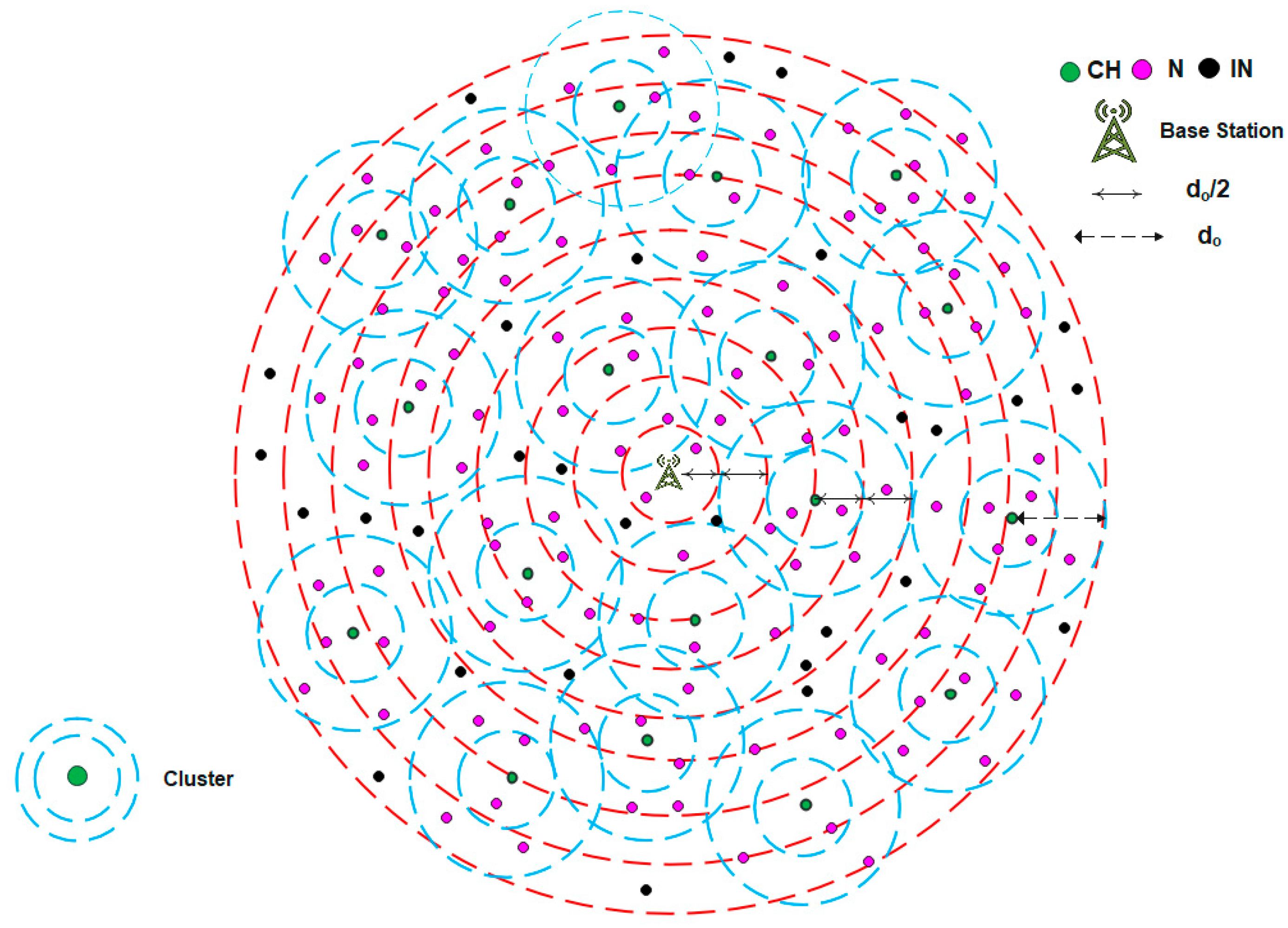
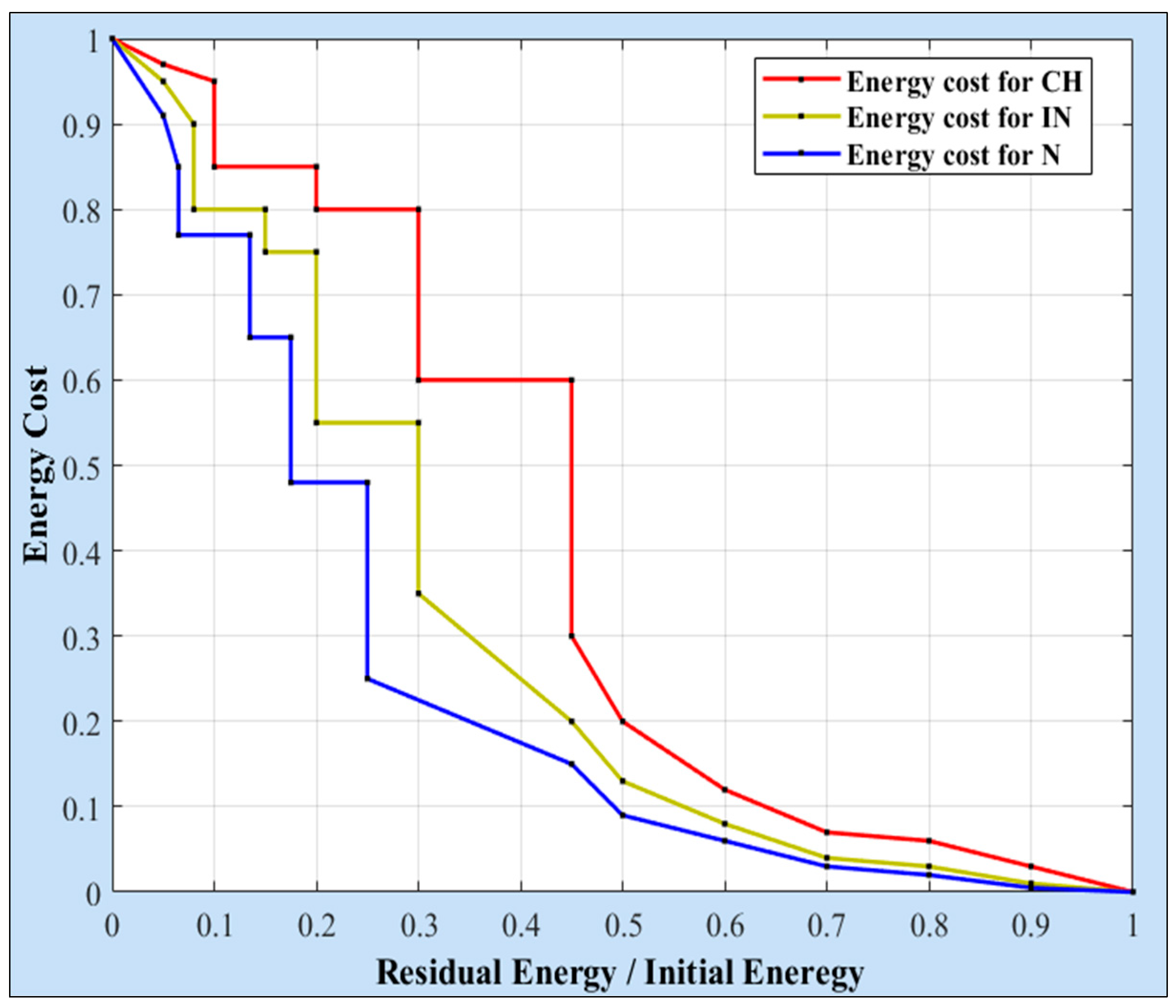


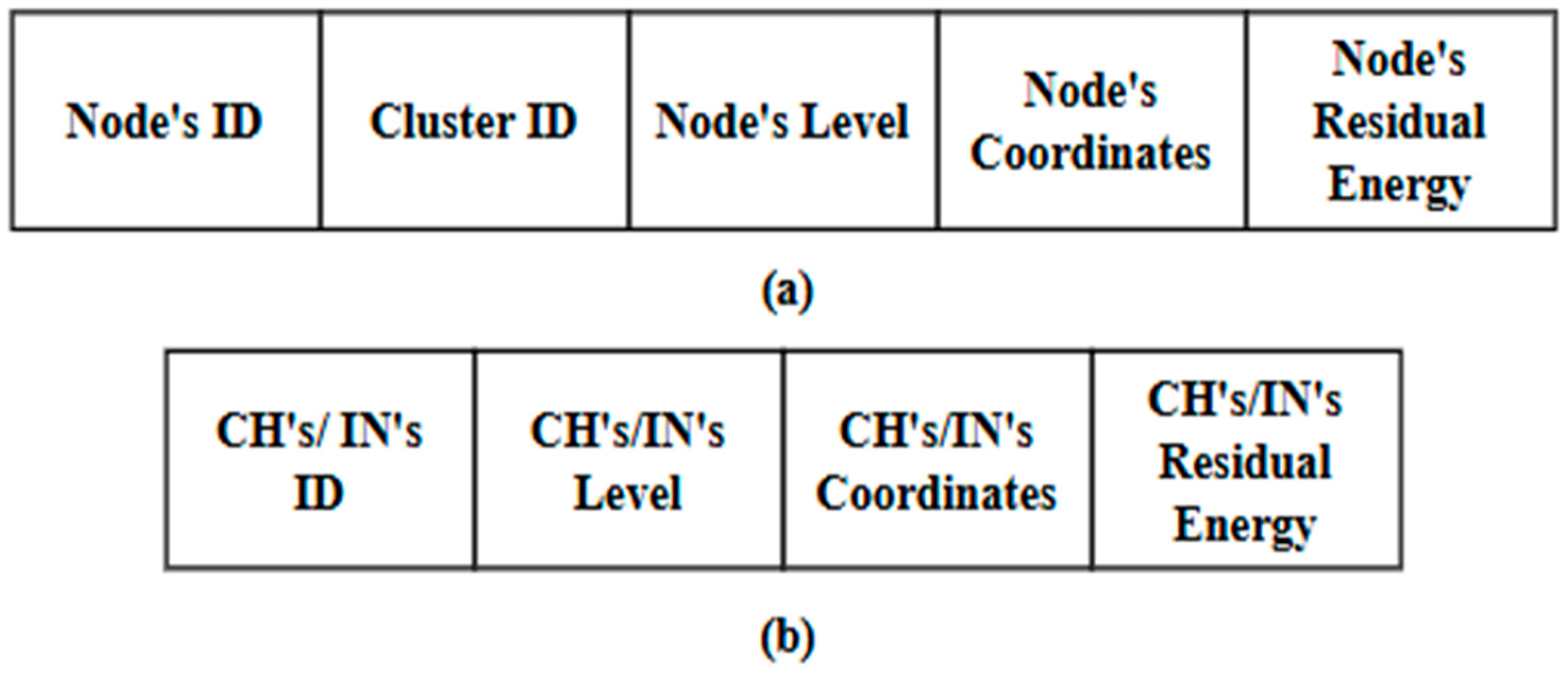
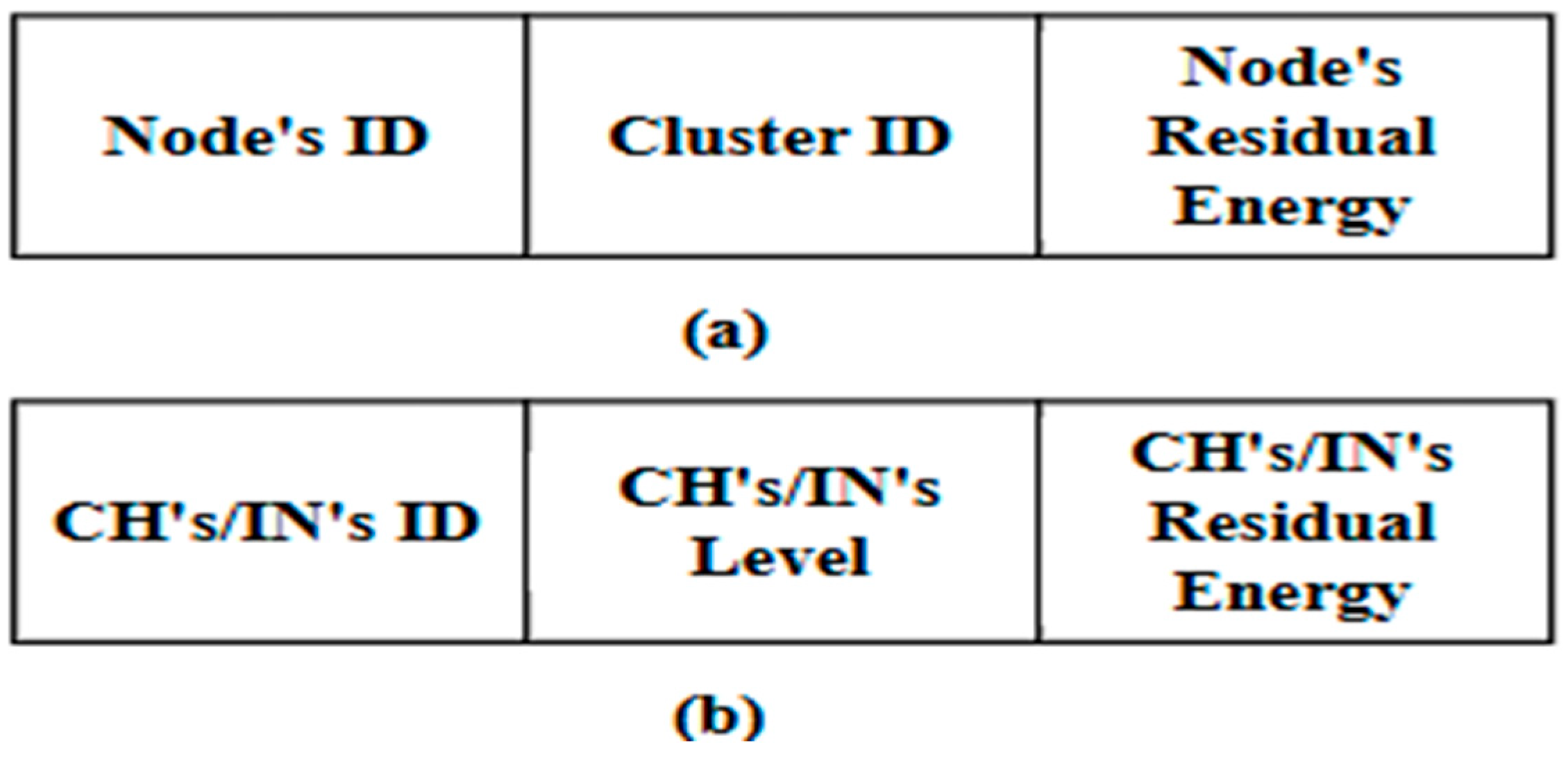

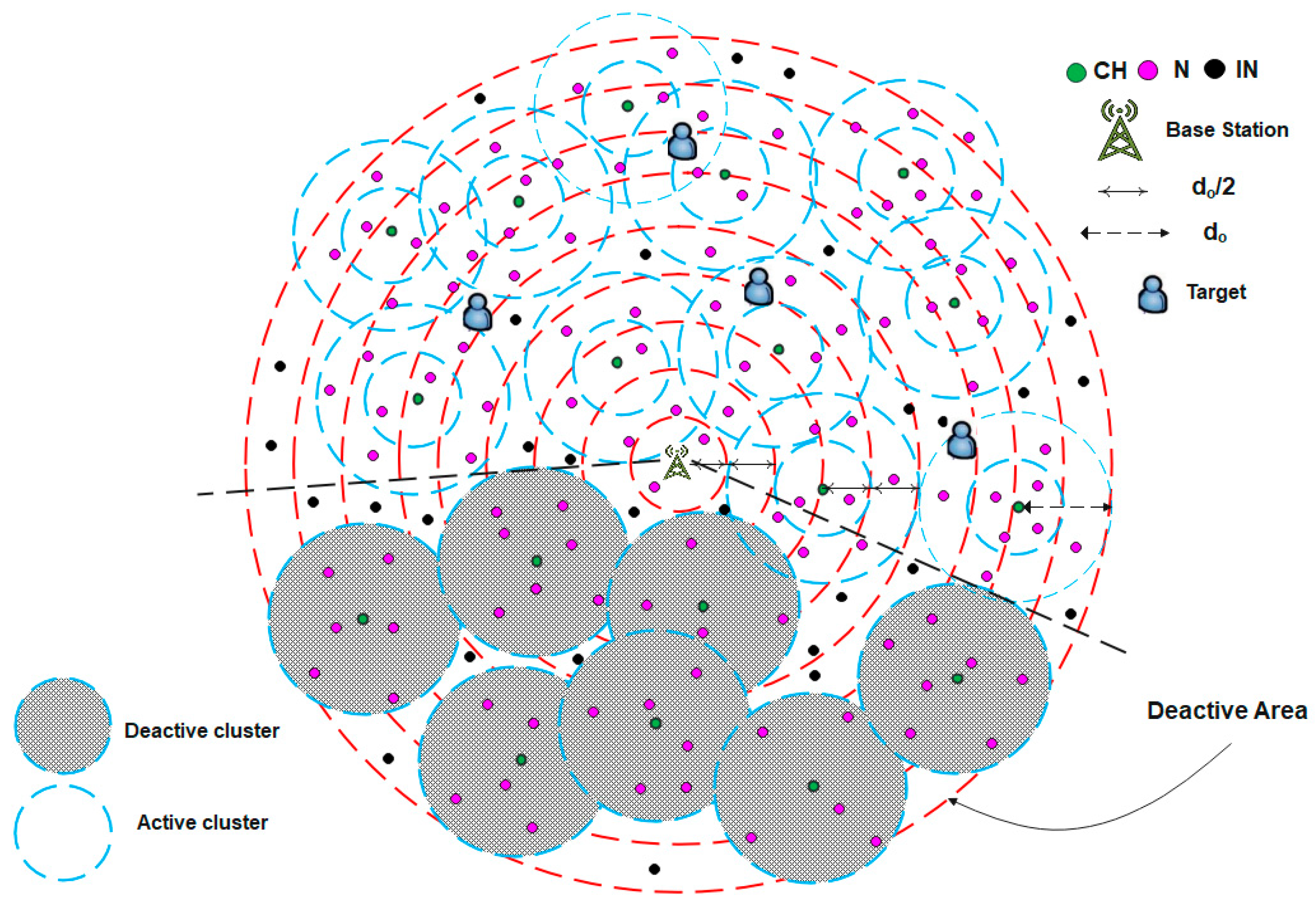

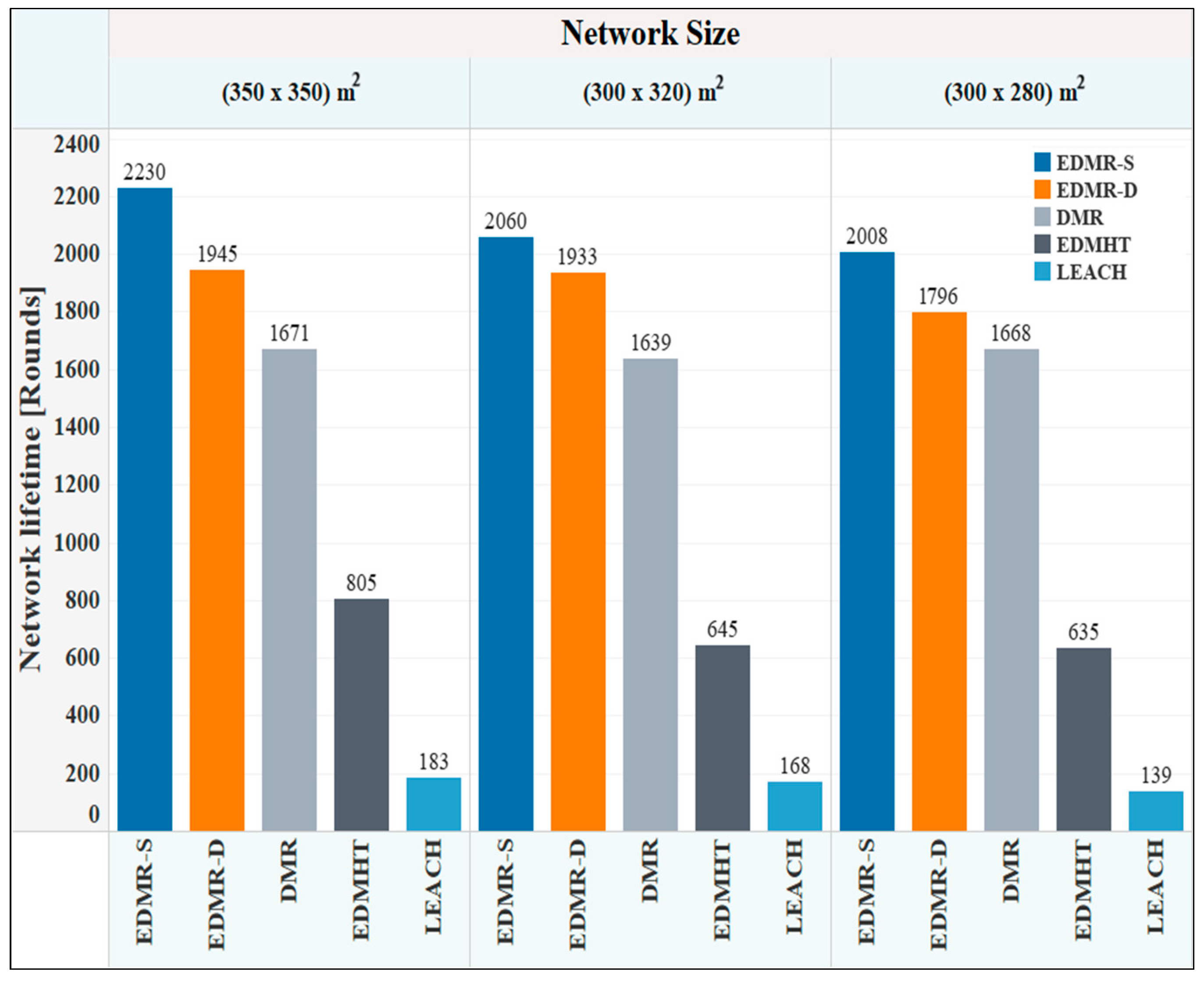
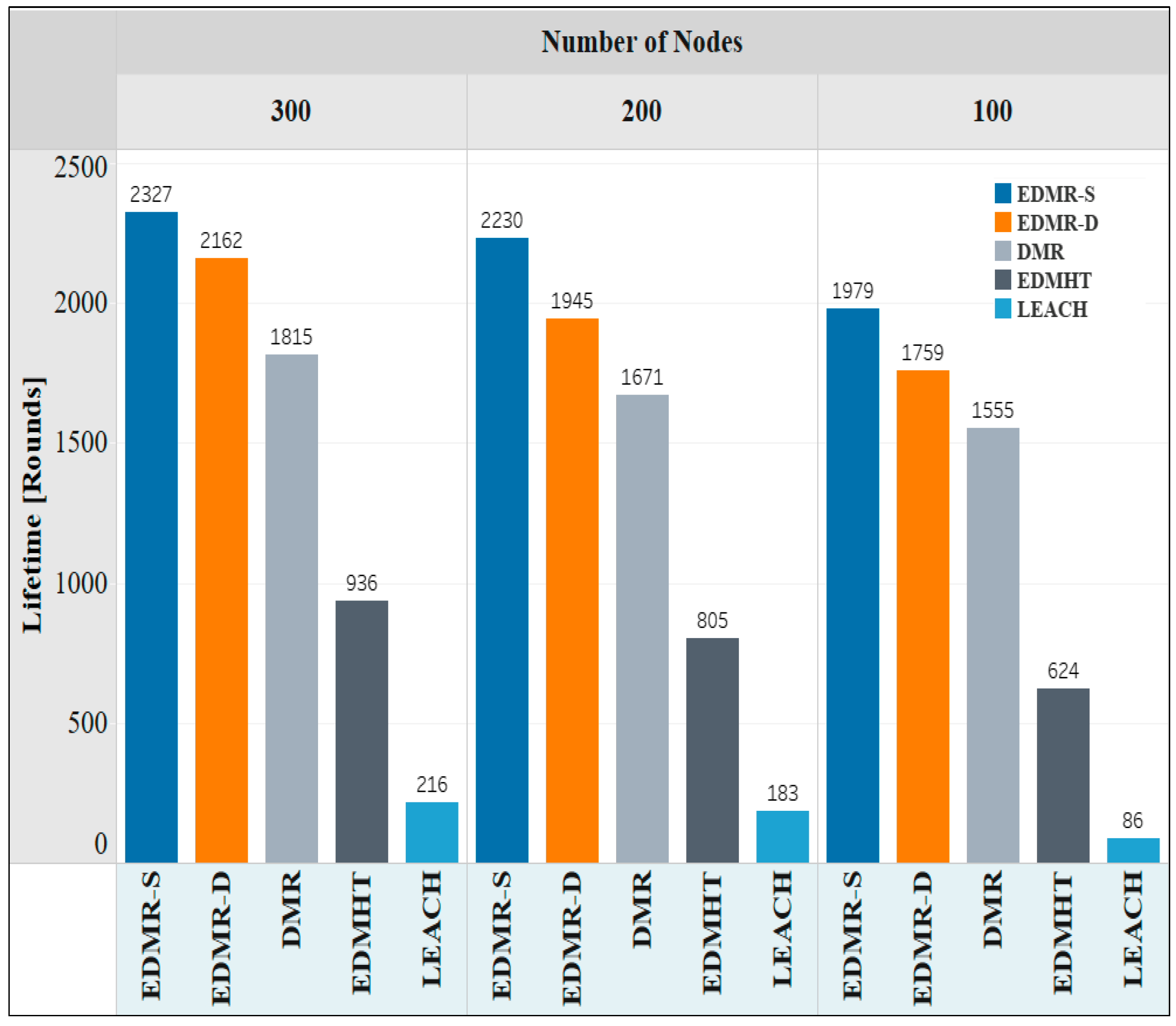
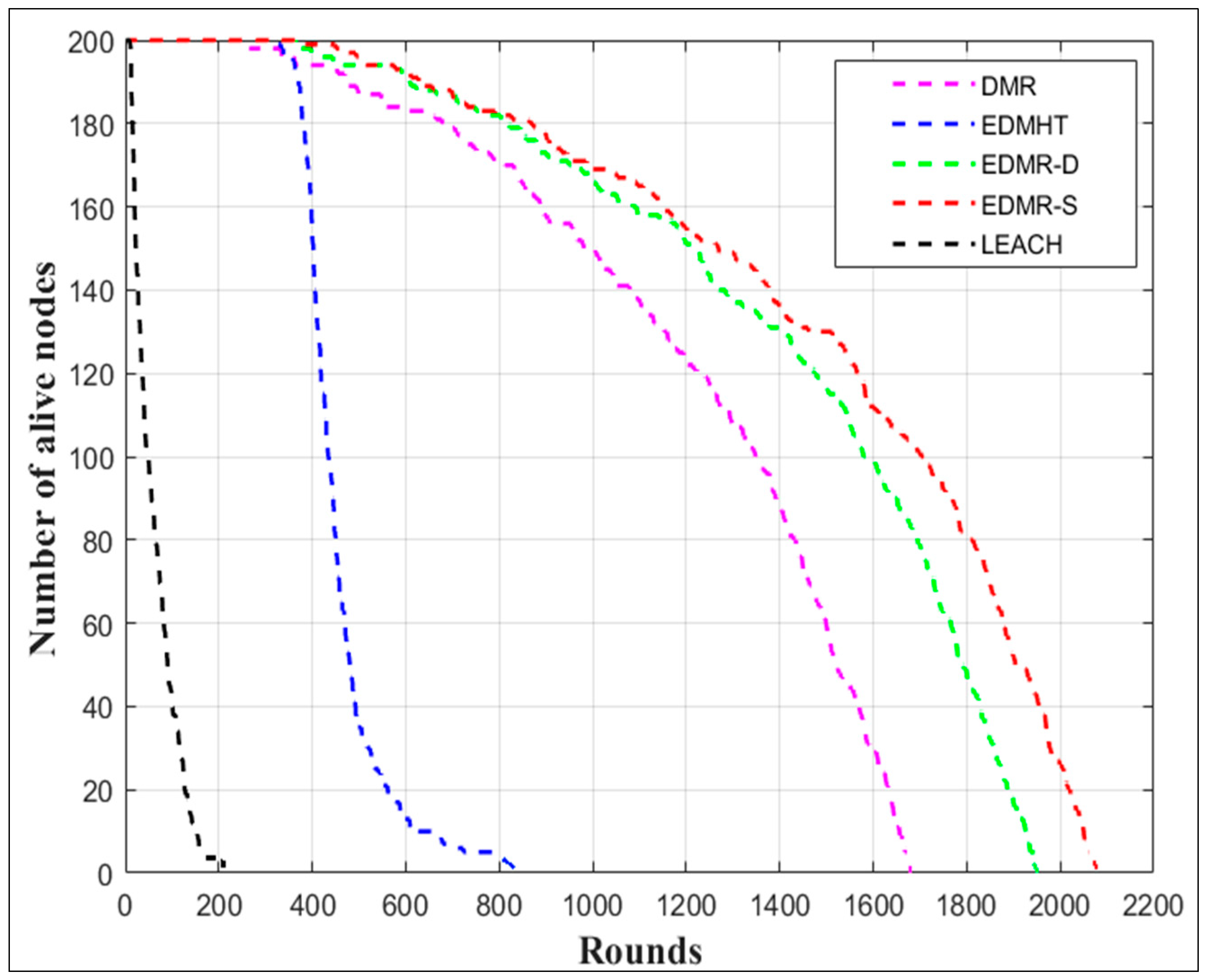
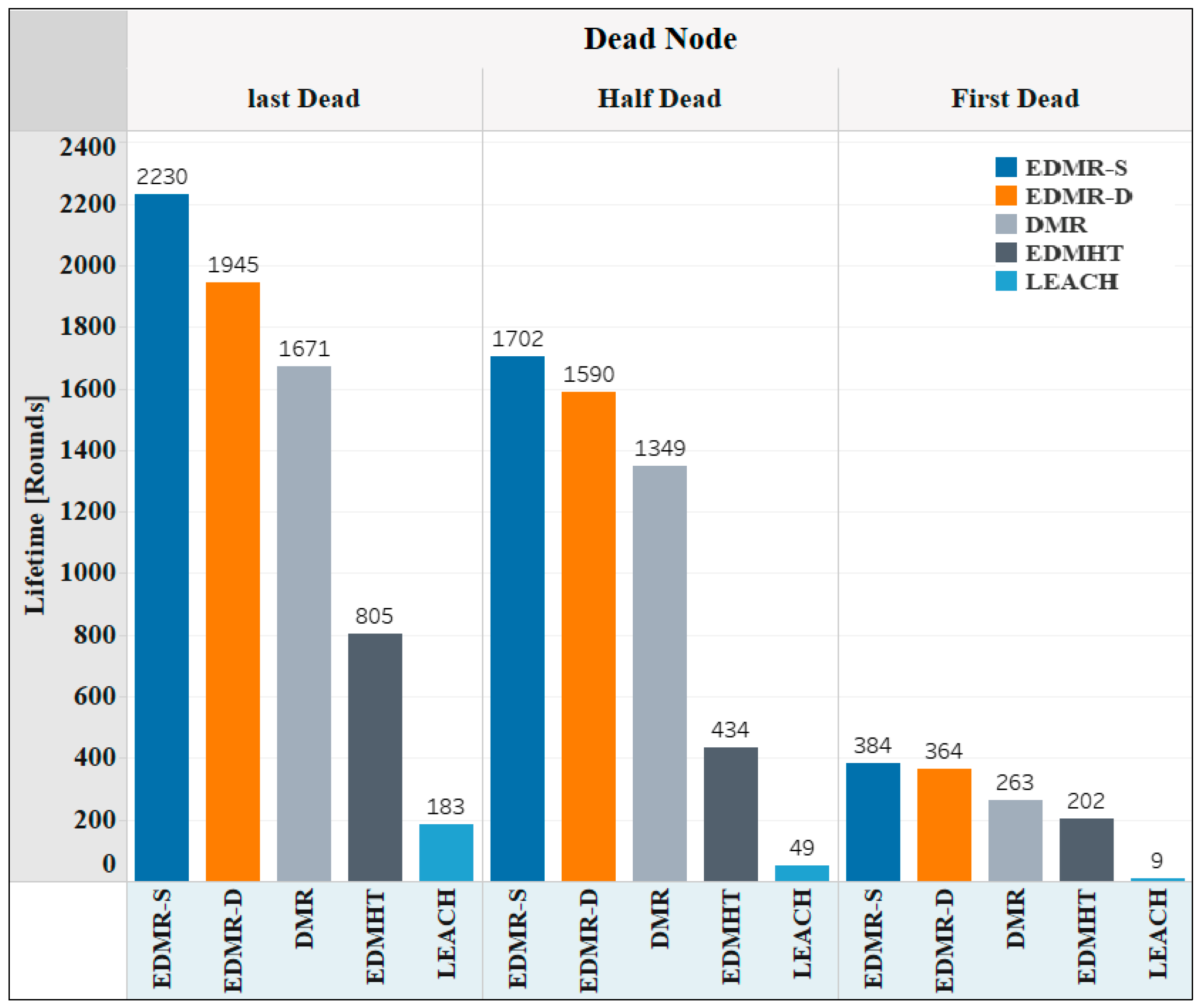

| Reference | Protocol Name | Sleep Scheduling Mechanism | Sleep Scheduling Control Level | Routing Method | Application-Adapted Sleep Mechanism | Independent Node Unit (IN) |
|---|---|---|---|---|---|---|
| [9] | MH-LEACH | No | - | Multi-hop (Static) | No | No |
| [10] | LEACH-TL | No | - | Multi-hop (Static) | No | No |
| [11] | EDMHT | No | - | Multi-hop (Dynamic) | No | Yes |
| [12] | K-means | Yes | CH-Level | Single-hop | No | No |
| [13] | EESAA | Yes | Pair-based Level (Pair of Nodes) | Single-hop | No | No |
| [14] | SEED | Yes | Node-Level | Single-hop | No | No |
| [15] | T-LEACHSAS | Yes | CH-Level | Single-hop | No | No |
| [16] | IT2FUSS | Yes | Node-Level (Fuzzy) | Single-hop | No | No |
| [17] | ETAAR | Yes | CH-Level | Multi-hop (Static) | No | No |
| [18] | DE-MAC | Yes | CH-Level | Single-hop | No | No |
| [19] | RMIS | Yes | CH-Level | Single-hop | No | No |
| [20] | RL-Coop Event | Yes | Cluster-Level | Single-hop (Intra-cluster) | No | No |
| - | EDMR | Yes | BS-Level (Centralized) | Multi-hop (Dynamic) | Yes Dual-mode (Static/Dynamic) | Yes |
| Parameters | Values |
|---|---|
| BS coordinates (X1, Y1) | (150 m, 480 m) |
| Initial energy (Eo) | 0.5 |
| The percentage of CH (p) | 0.2 |
| Eelec | 50 nJ/bit |
| εfs | 10 pJ/bit/m2 |
| Tmin | 0.03 |
| Relative weight (α) | 100 |
| Data aggregated energy (EDA) | 5 nJ/bit |
| εmp | 0.0013 pJ/bit/m4 |
| TH | 0.03 |
| Data packet size | 6400 bit |
| Control packet size | 200 bit |
| Total Nodes | Field Dimensions (X2 × Y2) | BS Position (X1, Y1) |
|---|---|---|
| 200 | (350 m × 350 m) | (150 m, 480 m) |
| 200 | (300 m × 320 m) | (150 m, 480 m) |
| 200 | (300 m × 280 m) | (150 m, 480 m) |
| Total Nodes | Field Dimensions (x × y) | BS Position (x1, y1) |
|---|---|---|
| 100 | (350 m × 350 m) | (150 m, 480 m) |
| 200 | (350 m × 350 m) | (150 m, 480 m) |
| 300 | (350 m × 350 m) | (150 m, 480 m) |
Disclaimer/Publisher’s Note: The statements, opinions and data contained in all publications are solely those of the individual author(s) and contributor(s) and not of MDPI and/or the editor(s). MDPI and/or the editor(s) disclaim responsibility for any injury to people or property resulting from any ideas, methods, instructions or products referred to in the content. |
© 2025 by the authors. Licensee MDPI, Basel, Switzerland. This article is an open access article distributed under the terms and conditions of the Creative Commons Attribution (CC BY) license (https://creativecommons.org/licenses/by/4.0/).
Share and Cite
Alnawafa, E.; Allaymoun, M. EDMR: An Enhanced Dynamic Multi-Hop Routing Protocol with a Novel Sleeping Mechanism for Wireless Sensor Networks. Sensors 2025, 25, 4510. https://doi.org/10.3390/s25144510
Alnawafa E, Allaymoun M. EDMR: An Enhanced Dynamic Multi-Hop Routing Protocol with a Novel Sleeping Mechanism for Wireless Sensor Networks. Sensors. 2025; 25(14):4510. https://doi.org/10.3390/s25144510
Chicago/Turabian StyleAlnawafa, Emad, and Mohammad Allaymoun. 2025. "EDMR: An Enhanced Dynamic Multi-Hop Routing Protocol with a Novel Sleeping Mechanism for Wireless Sensor Networks" Sensors 25, no. 14: 4510. https://doi.org/10.3390/s25144510
APA StyleAlnawafa, E., & Allaymoun, M. (2025). EDMR: An Enhanced Dynamic Multi-Hop Routing Protocol with a Novel Sleeping Mechanism for Wireless Sensor Networks. Sensors, 25(14), 4510. https://doi.org/10.3390/s25144510






